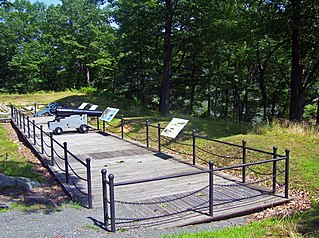
Fort Montgomery was a fortification built on the west bank of the Hudson River in Highlands, New York by the Continental Army during the American Revolution. Erected in 1776, Fort Montgomery was one of the first major investments by the Americans in strategic construction projects.

The cheval de frise was a defensive obstacle, existing in a number of forms, principally as a static anti-cavalry obstacle but also quickly movable to close breaches. The term was also applied to underwater constructions used to prevent the passage of ships or other vessels on rivers. In the anti-cavalry role the cheval de frise typically comprised a portable frame with many projecting spikes. Wire obstacles ultimately made this type of device obsolete.

John Hazelwood served as a Commodore in the Pennsylvania Navy and Continental Navy and was among the most noted naval officers during the American Revolutionary War. Born in England about 1726, he became a mariner and settled in Philadelphia early in life, became married and had several children. Promoted to Commodore during the Philadelphia campaign, he also became commander of Fort Mifflin while it was under siege by the British. Throughout the campaign Hazelwood and General Washington were in frequent communication with letters. During the weeks spent engaging the British navy on the Delaware River Hazelwood innovated many naval tactics, kept the British navy at bay for weeks and played a major role in the development of riverine warfare for the American navies. Recommended by Washington and his council, Hazelwood was chosen to lead a large fleet of American ships and riverboats up river to safety. For his bravery and distinguished service Congress awarded him with a ceremonial military sword, while the famous presidential artist Charles Peale found Hazelwood worthy enough to paint his portrait. After the Revolution Hazelwood lived out his remaining years in Philadelphia.

Fort Mifflin, originally called Fort Island Battery and also known as Mud Island Fort, was commissioned in 1771 and sits on Mud Island on the Delaware River below Philadelphia, Pennsylvania near Philadelphia International Airport.
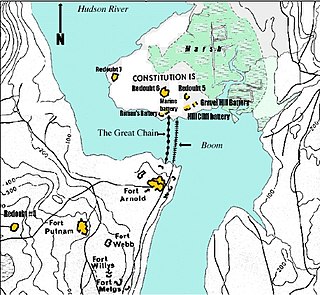
The Hudson River Chains were a series of chain booms constructed across the Hudson River at West Point by Continental Army forces from 1776 to 1778 during the American Revolutionary War. These served as defenses preventing British naval vessels from sailing upriver and were overseen by the Highlands Department of the Continental Army.

A redoubt is a fort or fort system usually consisting of an enclosed defensive emplacement outside a larger fort, usually relying on earthworks, although some are constructed of stone or brick. It is meant to protect soldiers outside the main defensive line and can be a permanent structure or a hastily constructed temporary fortification. The word means "a place of retreat". Redoubts were a component of the military strategies of most European empires during the colonial era, especially in the outer works of Vauban-style fortresses made popular during the 17th century, although the concept of redoubts has existed since medieval times. A redoubt differs from a redan in that the redan is open in the rear, whereas the redoubt was considered an enclosed work.

Fort Lee Historic Park is located atop a bluff of the Hudson Palisades overlooking Burdett's Landing, known as Mount Constitution, in Fort Lee, New Jersey, United States. The park was conceived as early as 1952.
The 2nd New Jersey Regiment was raised, on 9 October 1775, at Trenton, New Jersey, for service with the Continental Army under the command of Colonel William Maxwell. The regiment would see action at the Battle of Trois-Rivières, Battle of Valcour Island, Battle of Brandywine, Battle of Germantown, Battle of Crooked Billet, Battle of Monmouth, Sullivan Expedition, Battle of Springfield and the Battle of Yorktown. The regiment was furloughed, on 6 June 1783, at Newburgh, New York, and disbanded 3 November 1783.
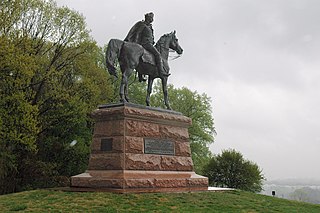
The Philadelphia campaign (1777–1778) was a British military campaign during the American Revolutionary War designed to gain control of Philadelphia, the Revolutionary-era capital where the Second Continental Congress convened and formed the Continental Army and appointed George Washington as its commander in 1775, and authored and unanimously adopted the Declaration of Independence the following year, on July 4, 1776, which formalized and escalated the war.

Robert Smith was a Scottish-born American architect who was based in Philadelphia and was the architect for some of the city's most prominent early building structures, including Carpenters' Hall, St. Peter's Episcopal Church, and the steeple on Christ Church. These structures constituted the greater part of Philadelphia's early skyline.

The Battle of Red Bank, also known as the Battle of Fort Mercer, was a battle fought on October 22, 1777, during the American Revolutionary War. A British and Hessian force was sent to take Fort Mercer on the New Jersey side of the Delaware River just south of Philadelphia, but was decisively defeated by a smaller force of Continental Army troops.

HMS Augusta was a 64-gun third rate ship of the line of the Royal Navy, launched on 24 October 1763 at Rotherhithe.

Fort Mercer was an earthen fort on the eastern shores of the Delaware River in New Jersey that was constructed by the Continental Army during the American Revolutionary War. The fort was built in 1777 by Polish engineer Thaddeus Kosciuszko under the command of George Washington. Along with Fort Mifflin on the Pennsylvania side of the Delaware River to its west, Fort Mercer was designed to block the British advance on the revolutionary capital of Philadelphia during the Philadelphia campaign.

The Red Bank Battlefield is located along the Delaware River in National Park, Gloucester County, New Jersey. It was the location of the Battle of Red Bank in the American Revolutionary War on October 22, 1777. Fort Mercer and its sister, Fort Mifflin in Pennsylvania, defended the river and prevented the British from using it for transportation. The forts successfully delayed the British, but in the end, they were both destroyed or abandoned.

The siege of Fort Mifflin or the siege of Mud Island Fort, which took place from September 26 to November 16, 1777, saw British land batteries commanded by Captain John Montresor and a British naval squadron under Vice Admiral Lord Richard Howe attempt to capture an American fort in the Delaware River that was commanded by Lieutenant Colonel Samuel Smith. The operation finally succeeded after Smith was wounded. His successor, Major Simeon Thayer, subsequently evacuated the fort on the night of November 15, enabling British troops to occupy the place the following morning.

The Tinicum Island Rear Range Light is a lighthouse located in the Billingsport section of Paulsboro in Gloucester County, New Jersey, the rear of a pair of range lights marking a section of the channel in the Delaware River south of Philadelphia.

Francis Reynolds-Moreton, 3rd Baron Ducie was a British Royal Navy officer, peer and politician who participated in numerous engagements during the American War of Independence. He is largely noted for his role conflict at the Battle of Red Bank in 1777 during the Philadelphia campaign, involving the dual siege of Fort Mifflin and Fort Mercer. During this operation he was commander of the advance fleet on board HMS Augusta in an attempt to clear the way along the Delaware to Philadelphia. His ship ran aground while being pursued by Commodore Hazelwood's fleet when the vessel mysteriously caught fire shortly thereafter and exploded before all of the crew could abandon ship. Reynolds also commanded HMS Jupiter and HMS Monarch in several operations and saw service against the French in the North Sea, European Atlantic coast and the Caribbean theaters.
The Port of Paulsboro is located on the Delaware River and Mantua Creek in and around Paulsboro, in Gloucester County, New Jersey, approximately 78 miles (126 km) from the Atlantic Ocean. Traditionally one of the nation's busiest for marine transfer operations, notably for crude oil and petroleum products, such as jet fuel and asphalt, it is a port of entry with several facilities within a foreign trade zone.
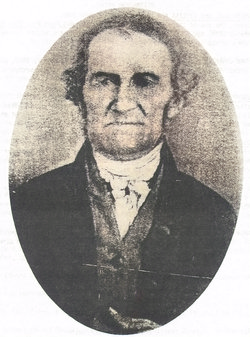
John Bull politician, military officer, statesman, and planter. Initially, his military career started under John Forbes in the Forbes Expedition during the 1750s. During the American Revolution, he was a delegate in the Pennsylvania Provincial Conference which declared Pennsylvania independent from the British Colonies. Benjamin Franklin and Bull sat on many committees together. Bull was a very active participant in many different roles during the revolution. He was mainly in charge of the defenses of Fort Billingsport. He held the rank of Colonel in Pennsylvania's 2nd Regiment and eventually rose to the rank of Adjutant General of the Pennsylvania Militia by the Pennsylvania Supreme Executive Council in defense of Philadelphia during the Philadelphia campaign.
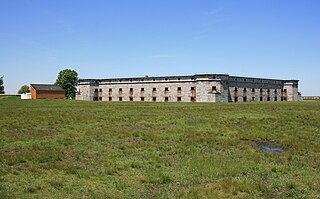
The Harbor Defenses of the Delaware was a United States Army Coast Artillery Corps harbor defense command. It coordinated the coast defenses of the Delaware River estuary from 1897 to 1950, beginning with the Endicott program. These included both coast artillery forts and underwater minefields. The areas protected included the cities of Philadelphia, Camden, and Wilmington along with the Chesapeake & Delaware Canal. The command originated circa 1896 as an Artillery District and became the Coast Defenses of the Delaware in 1913, with defenses initially at and near Fort Delaware on Pea Patch Island near Delaware City. In 1925 the command was renamed as a Harbor Defense Command. During World War II the defenses were relocated to Fort Miles on Cape Henlopen at the mouth of the Delaware Bay.



















